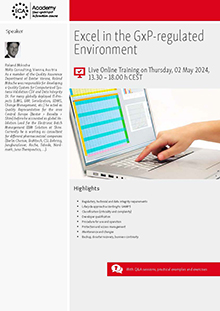Elemental impurities - A database to facilitate the risk assessment of active ingredients and excipients

Recommendation
Thursday, 2 May 2024 13.30 - 18.00 h
Released in December 2014, the ICH Q3D Guideline on Elemental Impurities contains extensive specifications for the control of a total of 24 elements (21 metals, 3 metalloids) that can be present as impurities in pharmaceutical products. Main sources can be
- Active ingredients
- Excipients (including water)
- Processing auxiliaries and catalysts
- Production equipment
- Container and closure systems
The Guideline ICH Q3D calls for a risk assessment with regard to the presence of metallic impurities in various dosage forms, taking into account the respective limit values. The main factors of influence are to be included (see fishbone diagram on p. 6 of the Guideline). The risks identified in a comprehensive analysis have then to be categorized in a meaningful and justifiable manner.
The data for the content of metallic impurities, e.g. in excipients (for this purpose there is a study conducted by the FDA) or of migratable impurities in container / closure systems (there exists a Literature review in the PDA journal of pharmaceutical science and technology) is rather thin. And the sources of information can only be found through extensive research. The greatest treasure of information is located in the databases of several pharmaceutical and API manufacturers which have carried out analytical studies already.
To merge these data and information and to make them available to all interested companies in the form of a database, representatives of eight major companies have joined forces to an "Elemental Impurities Pharma Consortium". This group was formed in October 2013, after a Conference on "Elemental Impurities" conducted by the Joint Pharmaceutical Analysis Group (JPAG).
The database that is currently established under the auspices of the EI Pharma Consortium, now comprises analytical data on elemental impurities from over 100 different materials (pharmaceutical excipients, dyes, etc.), which were provided by other companies. These data are anonymized, so that interested users of the database can not recognize the specific origin of the information.
The benefit for the user increases to the same extent as the database grows, which basically means for the companies that have to implement one of the main requirements of the ICH Q3 Guideline - to carry out a risk assessment. The timeframe for this is tight: for medicinal products still to be approved the provisions of ICH Q3D need to be fulfilled by June 2016. Already approved products have to comply from December 2017 (see also our news "Industry Coalition" gives practical advice for the control of elemental impurities in active substances and excipients).
Note : At the Impurities Forum from 16-18 June 2015 in Prague you will receive more information about this topic. Andrew Teasdale, one of the initiators of the Consortium, will report about the database and the possibilities to use it.
Related GMP News
GMP Conferences by Topics
- General Quality Assurance and GMP Compliance Topics
- Hygiene
- General Microbiology Topics
- Regulatory Affairs
- Development
- General Analytics Topics
- Good Distribution Practice
- Sterile Manufacturing
- Computer Validation
- General Qualification/Validation Topics
- General Engineering Topics
- APIs/Excipients
- GMP Basic Training Courses
- Medical Devices and Combination Products
- Packaging and Packaging Material
- Data Integrity
- Qualified Person (QP)
- GMP Auditing
- Documentation
- Cleaning Validation
- General IT Compliance Topics
- Impurities
- OOS / OOE / OOT
- Material Testing
- Validation of Analytical Methods
- Analytical Instrument Qualification
- Stability Testing
- Microbiological Testing
- Technology
- General Manufacturing Topics
- Solid Dosage Forms/Semi-Solid Dosage Forms
- Biotechnology/Blood/ATMP
- Herbal Drug Products/Cannabis/Radiopharmaceuticals
- Others




